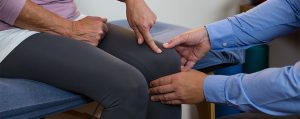Tips from a PT: How to Fall-Proof Your Home
Unfortunately, thousands of older adults aged 65 and older sustain a fall each year. Many falls lead to injuries that vary in severity. Falls can happen anywhere, but the majority of them occur in the home. Our homes can be full of hidden hazards. One way to reduce you or a loved one’s risk of falling is to fall-proof your home. For elderly families that may be visiting during the upcoming holidays, these helpful tips can keep everyone safe.
How Your iPhone Can Help Decrease Your Risk of Falling
With advancements in technology, detecting a fall is easier than ever! Apple Watches have been able to detect a fall for some time, a feature automatically added for anyone 55 years and older. Emergency medical response teams may even be called based on one’s movement, or lack thereof, after the impact or fall. However, the latest feature – Walking Steadiness – available on the Apple iOS 15 update now allows the phone to send you a notification related to the steadiness of your walking. This update can help recognize your risk for falls before they happen.
Caregivers: Your Guide to Fall Prevention
Choosing to become a caregiver for a loved one or friend is a kindhearted act. Deciding to provide personal care for someone takes patience and attentiveness. Grocery shopping, housework, cooking, and managing services are typical duties of a caregiver. Along with day-to-day assistance, creating a safe environment is very important to minimize injury to yourself and others.
How to Fall Correctly to Prevent Hand Injuries
As a physical therapist and hand therapist, one of the biggest concerns I hear from my patients is that they are worried they are going to fall and hurt themselves. It is not uncommon for a therapist to be treating injuries that resulted from a fall. The upper extremity (shoulder through the fingers) is a common place for injuries to occur following a fall as many will use their hands to brace their fall in order to protect their face or head. This type of fall is called a F.O.O.S.H or a fall on an outstretched hand. This blog will briefly look into common injuries of the upper extremity with a fall and will talk about ways to prevent these injuries.
Fall Prevention: Tips to Prevent Falls
Mary Lehnen, PT, DPT and Laura Flanigan, MSOT, OTR/L
Why is fall prevention important? Physical and occupational therapists frequently treat patients whose injuries were caused by a fall. According to the Centers for Disease Control and Prevention (CDC), falls are the leading cause of fatal and nonfatal injuries for adults who are 65 years and older. Falls can lead to serious nonfatal injuries, including fractures of the head and hip. A fall on an outstretched hand, also known as a “FOOSH” injury, can lead to fractures and soft tissue tears of the hand, wrist, forearm and even the shoulder. Falls can be emotionally traumatic to some patients and they may avoid participating in exercise, leisure and necessary daily activities due to fear of falling. This can lead to deconditioning, isolation and negatively impacting an individual’s overall well-being and independence.
Are You at Risk for Falling?
The fall season is almost over for 2019, but for adults over the age of 65 the fall season never ends. According to the National Council on Aging, one out of every four older adults fall each year and of those seniors who fall, every 11 seconds they go to an ER. What’s even more alarming is that every 19 minutes someone dies from a fall related injury. Falls are the leading cause of fatal and non-fatal injuries in senior citizens.1
Give the Gift of Fall Prevention for the Holidays
The holidays are fast approaching! With all the yummy food and many miles to travel also comes time with our families. Many of us will visit our aging parents or grandparents, and amidst conversations around jobs or children, we may find ourselves hearing about an injury or fall that has occurred.
Home Safety Tips for Arthritis Sufferers
May is National Arthritis Awareness Month. Millions of Americans are affected by the symptoms of arthritis everyday. Arthritis can lead to stiff and painful joints which can often make balance and strength worse among this population. This decline in our functioning is often a leading factor of falls in the elderly. Most of these falls occur in or around the individual’s own home. Here is a list of some important safety tips to help reduce the incidence of falls in the senior population: (more…)
